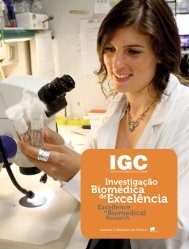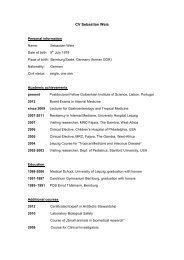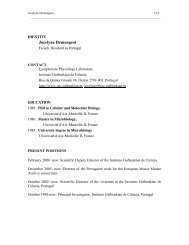organisation - the Instituto Gulbenkian de Ciência
organisation - the Instituto Gulbenkian de Ciência
organisation - the Instituto Gulbenkian de Ciência
- No tags were found...
Create successful ePaper yourself
Turn your PDF publications into a flip-book with our unique Google optimized e-Paper software.
IMMUNE<br />
REGULATION<br />
Carlos E. Tadokoro Research Fellow<br />
PhD in Immunology, University of São Paulo, 2001<br />
Post-doctoral fellow, New York University, USA<br />
Research Fellow at <strong>the</strong> IGC since 2010<br />
link to external website<br />
The ultimate function of <strong>the</strong> immune system is to cooperate with o<strong>the</strong>r body<br />
systems in or<strong>de</strong>r to maintain homeostasis within multi-cellular organisms.<br />
To perform such a task, cells and molecules of <strong>the</strong> immune system evolved to<br />
distinguish between “self” and “non-self” molecules. We are interested in better<br />
un<strong>de</strong>rstanding <strong>the</strong> regulation that occurs insi<strong>de</strong> <strong>the</strong> immune system, focusing<br />
our attention on a particular cell type called regulatory T cell. We combine<br />
classical cellular analyses with intra-vital imaging techniques to investigate <strong>the</strong><br />
function of immune cells in tissues un<strong>de</strong>r various conditions of activation/inflammation.<br />
To this aim, we <strong>de</strong>velop surgical procedures and tools to perform<br />
<strong>the</strong>se analyses using two-photon microscopy, which allow <strong>the</strong> observation of<br />
single-cell dynamics and cell interactions as well as <strong>the</strong>ir spatial localization<br />
insi<strong>de</strong> <strong>the</strong> organs.<br />
GROUP MEMBERS<br />
Márcia M. Me<strong>de</strong>iros (Post-doc, started at November)<br />
Henrique B. Da Silva (Visiting Ph.D. Stu<strong>de</strong>nt (collaborator))<br />
Susana Caetano (Research Technician, started in September)<br />
COLLABORATORS<br />
Juan J. Lafaille (New York University, USA)<br />
Michael L. Dustin (New York University, USA)<br />
Cláudio R. F. Marinho (University of São Paulo, Brazil)<br />
Maria Regina D'Império Lima (University of São Paulo, Brazil)<br />
Ana Cláudia Zenclussen (Otto-von-Guerricke University, Germany)<br />
FUNDING<br />
Fundação para a Ciência e a Tecnologia (FCT), Portugal<br />
GENERATION OF NEW TRANSGENIC ANIMALS<br />
FOR in vivo TRACKING OF REGULATORY T CELLS<br />
The main objective of this project is to <strong>de</strong>velop new tools to acquire information<br />
about in vivo tracking of a specific type of cell insi<strong>de</strong> <strong>the</strong> immune system<br />
called Regulatory T Cells (Tregs). We will <strong>de</strong>velop tools to allow <strong>the</strong> in vivo<br />
cell fate mapping of Tregs insi<strong>de</strong> organs and also throughout <strong>the</strong> rest of <strong>the</strong><br />
mouse body. We will <strong>de</strong>velop new intra-vital microsurgeries, use “two-photon”<br />
microscopy, and generate new genetically engineered animals to track any cell<br />
of interest. The major challenge is no longer <strong>the</strong> microscopes used, but in <strong>the</strong><br />
<strong>de</strong>velopment of intra-vital microsurgeries that allow <strong>the</strong> exposure of internal<br />
organs with minimal or no trauma. Therefore, this project has a strong core in<br />
Research and Development (R&D). To visualise <strong>the</strong>se cells we will generate new<br />
genetically manipulated mouse lines expressing a photo-activated GFP (paGFP)<br />
un<strong>de</strong>r specific promoters and conditional transgenic mouse lines based on<br />
“Tet ON-OFF” systems.<br />
We <strong>de</strong>veloped intra-vital imaging techniques, in use by IGC groups (intra-vital<br />
imaging of placenta, used by <strong>the</strong> Disease genetics group) or international collaborators;<br />
submitted two papers: Zenclussen, A. C., et al, Clin. Invest; Silva, H.<br />
B., et al, Eur. J. Immunol.); and published two papers: Olivieri, D., et al, J. Integr.<br />
Bioinform., 2011 Sep 8(3):180).<br />
A<br />
B<br />
In vivo PICTURE OF PLACENTA BLOOD FLOW.<br />
A - Maternal blood in red and foetal blood in green, with arrow showing <strong>the</strong> region<br />
of chorionic plate. B - Higher magnification of placenta, showing <strong>de</strong>tails of chorionic<br />
plate and labyrinth zone.<br />
3D reconstruction of uterus, showing DC distribution (green), during oestrus phase<br />
of oestrus cycle.<br />
IGC ANNUAL REPORT ‘11<br />
RESEARCH FELLOWS<br />
81






